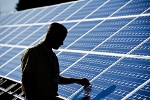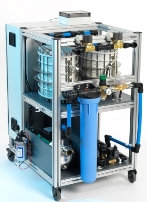
Obama administration announces plans to install new solar panels on the White House residence.
On the high end, cars will be expected to achieve 60 miles per gallon by the year 2025.
This is the first federal court action brought by the government under the marine diesel engine rules.
The Bureau of Ocean Energy Management, Regulation and Enforcement, formerly MMS, has developed rules for offshore oil and gas operations in federal waters that require operators to develop and follow a 13-point Safety and Environmental Management System.
The Center for Progressive Reform's new study recommends regulators apply the "precautionary principle" to assess risks and needed safeguards.
EPA and the Justice Department announced the penalty and posted the consent decree that has been filed in a Houston federal court. It is a record civil penalty for Clean Air Act violations at an single facility.
An atomically dispersed platinum catalyst could replace a copper-based catalyst currently being studied for use in on-board hydrogen production in fuel cells.

Faster development of the promising field of cellulosic biofuels -- the renewable energy produced from grasses and trees -- is being significantly hampered by a "deep and thorny regulatory thicket" that makes almost impossible the use of advanced gene modification methods, researchers say.

This is the second installment of a multi-part series on some of today's problems in land development and how innovative methods collectively known as "Prefurbia" can help overcome them.
Through the Department of Energy's Geothermal Technologies Program, the company will apply $2 million toward its research on carbon dioxide-based geothermal power production.

An Oceana analysis shows that offshore wind potential is so high off the U.S. Atlantic coast that investments in offshore wind power in Atlantic waters could generate about 30 percent more electricity than economically recoverable offshore oil and gas in the same region combined.
The report from U.S. Navy Secretary Ray Mabus says the money will be used for recovery through a coordinated federal, state and local, long-term strategy
The International City/County Management Association found that while local governments recognized the need to create sustainability, they generally have not been able to act on that knowledge.
Researchers in EPA's National Risk Management Research Laboratory in Ohio tested the ability of oil to biodegrade after 20 years and discovered that oxygen was the limiting factor.

New evidence from Brazil suggests water in the atmosphere picks up electrical charges, which could be collected much like the sun's energy.
The company will pay a $1.25 million civil penalty, upgrade pollution control technologies, and install covers on two wastewater tanks as a supplemental environmental project.
Research laboratories will be assessing national standards, reviewing power systems, and testing protocols for grid security technologies.

By observing cloud shape, size and movement, the system provides a way for utility companies to predict and prepare for fluctuations in power output due to changes in weather.
Nearly 1 million charging stations are expected to be installed across the United States; activity is already starting with collaborations and investment across the country.

The Anglo-Dutch company has based its technology on oppositely charged electrodes combined with anionic and cationic selective membranes.